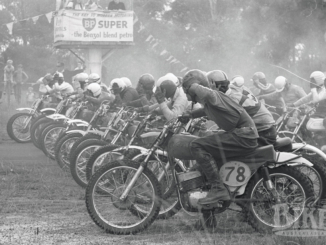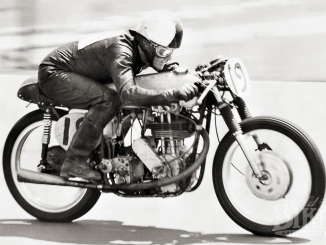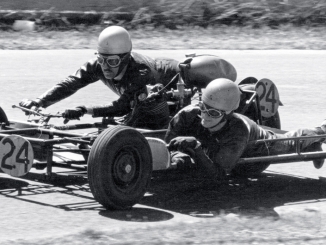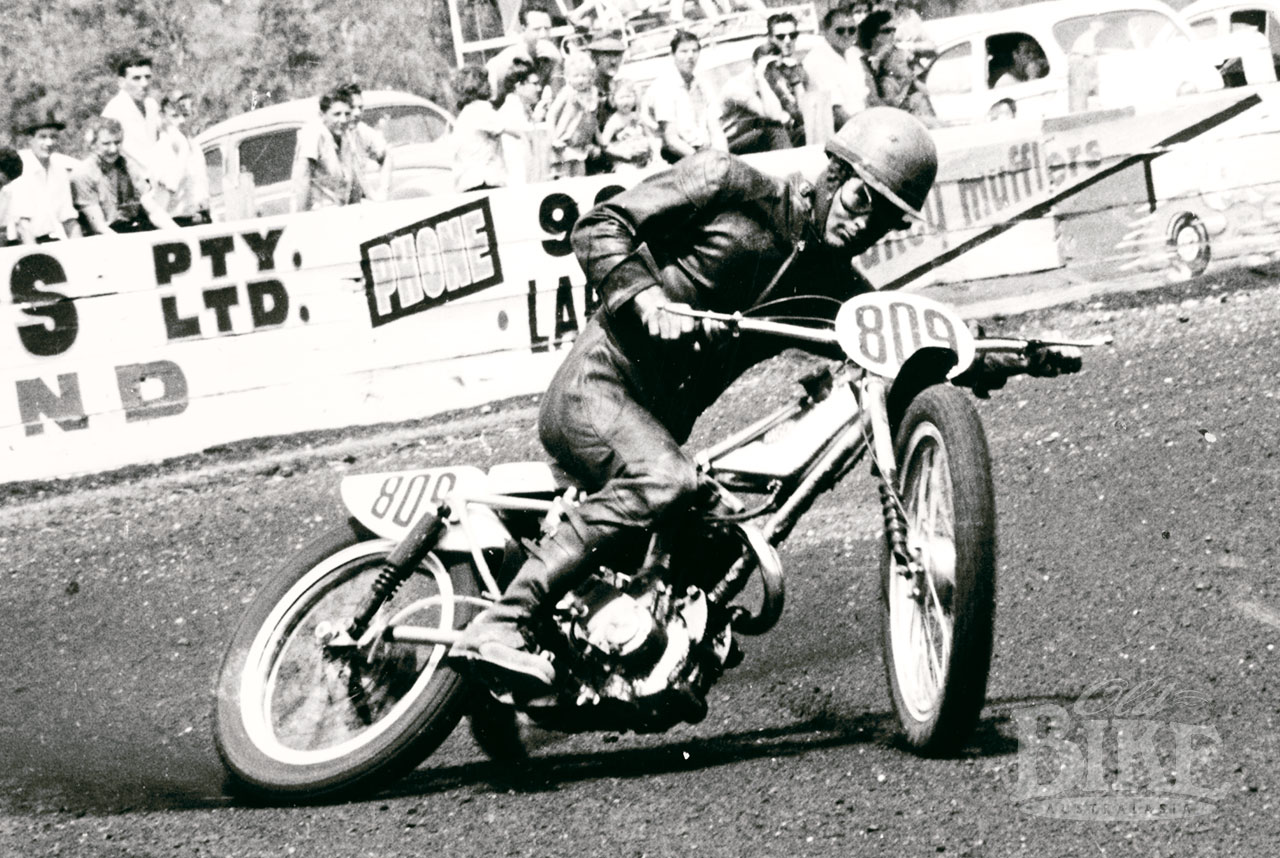
From our Old Bike Archives – Issue 9 – first published in 2008.
Story: Jim Scaysbrook • Photos: Michael Andrews, OBA archives.
Motorcycling is full of legends, but in the field of Australian dirt track racing, they don’t come any bigger than Herb Jefferson. Always torn between his twin loves of surfing and motorcycle racing, the sun-tanned icon ruled the roost in the 1960s when Dirt Track was called Short Circuit. He was a tough as nails competitor, a professional in a sea of weekend racers, and he quit the scene as suddenly as he came upon it.
William Trevor (Herb) Jefferson, born in New Lambton on 27th June, 1942, picked a tough school to master. The Newcastle area was alive with dirt track heroes; John Rumford, Norm Fraser, Dave O’Brien and Jack Davies to name but a few. But from the time the 19 year old first took to the tracks in 1962, he had star-quality written all over him.
Herb’s first experience with bikes displayed the rebellious nature for which he became famous. “I used to get out of bed at night and borrow the old man’s ‘ride-to-work’ hack and take it for a midnight blip. He couldn’t work out why his bike used so much gas! One night he waited up late and caught me fangin’ it out up the lane. After that he bought me an old bush bike.”
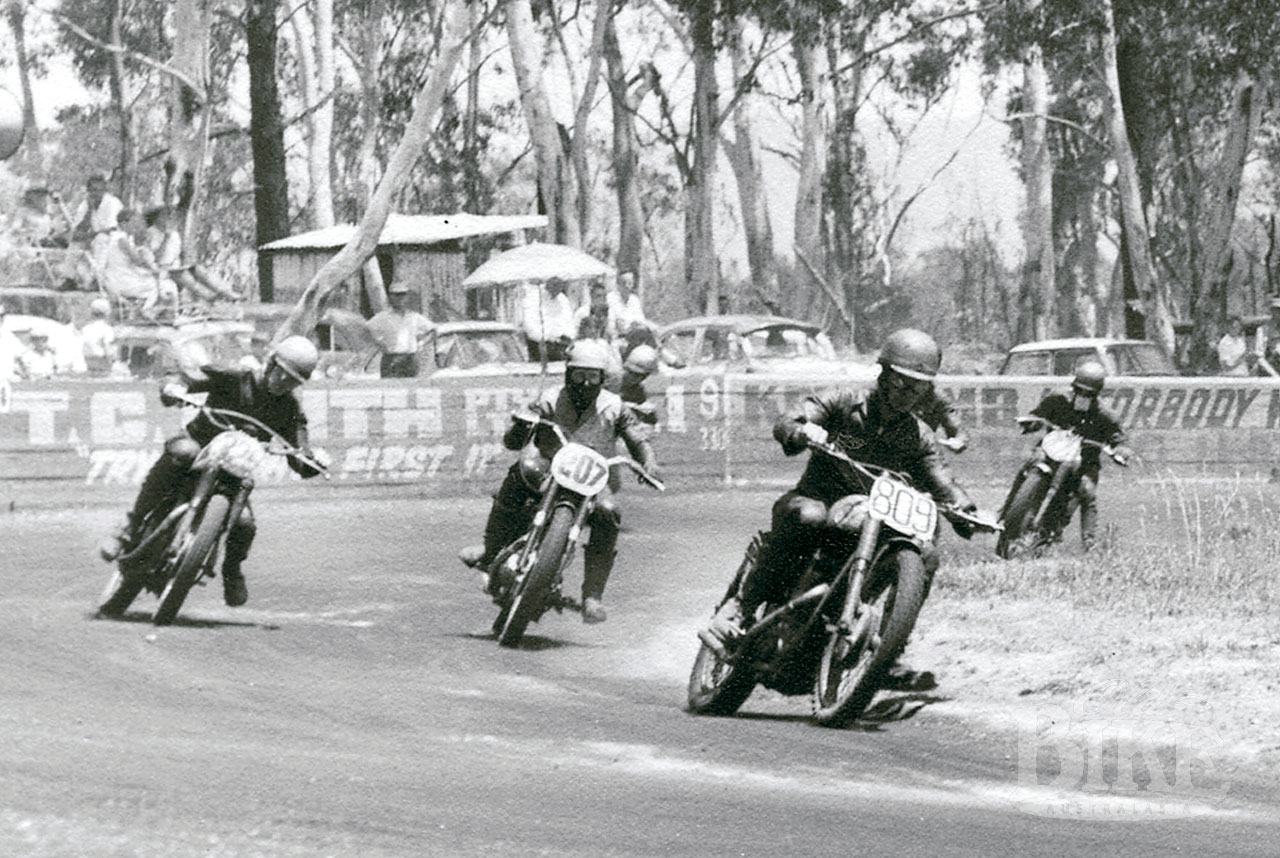
As a self-styled ‘wild one’ on a British big twin, Herb’s road riding lasted just two years after receiving his licence at the minimum age of 16 years 9 months. Numerous speeding fines resulted in two licence suspensions, so he turned his attention to racing at the plethora of circuits in his area, among them Heddon Greta, Salty Creek, Taree and Kempsey. Riding the ubiquitous iron-engined BSA, actually owned by his brother-in-law, in his very first race at Heddon Greta, he had the event shot to pieces when he inexplicably fell off on the last lap. His explanation was the he had only started racing ‘as a joke’, so it didn’t matter.
Life, in fact, was a bit of a joke to Herb. Regular OBA contributor Pet ‘Cob’ Smith, who grew up in Cessnock and rode a 1961 Triumph Bonneville that he claims was “the quickest road bike in the north” has clear memories of young Herb. “I used to frequent Newcastle a lot on the Bonnie, and got chased out of town on numerous occasions by the cops. I recall being at what they called ‘The top end of town’ – the eastern end of Hunter Street near the beach. I knew that Jefferson was a keen surfboard rider and that he spent most of his day on the beach, as he didn’t work. He had a 500 Gold Star with a sidecar that was fitted with board racks. At 4 pm he used to come from the beach area and turn left into Hunter Street and hold the sidecar wheel up for about 200 yards as he passed the shops. I couldn’t believe he was so brazen about it. I also recall him at Bathurst making a comment that somebody had started a malicious rumour about him claiming that he had found a job, but I also did hear that in the times that he frequented the Newcastle beach he had participated in several rescues.”

Despite numerous falls, Herb graduated from C to A Grade inside one year, and took his first Australian title, the 350cc Championship at Goulburn’s Boxers Creek track, while still a B-grader. In the next five years he amassed 26 state and national titles; along the way assuming the mantle of not just the most talented, but one of the toughest competitors on the tracks.
With a string of state Short Circuit titles already to his credit, Herb ventured outside his comfort patch to Tasmania in November 1963, for the Australian Short Circuit Championship at Spreyton Race Course at Devonport. On a 1.2 kilometre track inside the horse racing course, Herb defeated Dave “Sputnik” O’Brien and Ray Owen to take out the 350 title on his BSA, and placed third in the Senior on a JAP behind Jim Whyman’s ESO/BSA and O’Brien’s JAP. On a borrowed 250 Velocette, he also placed second to Whyman in the 250 class.
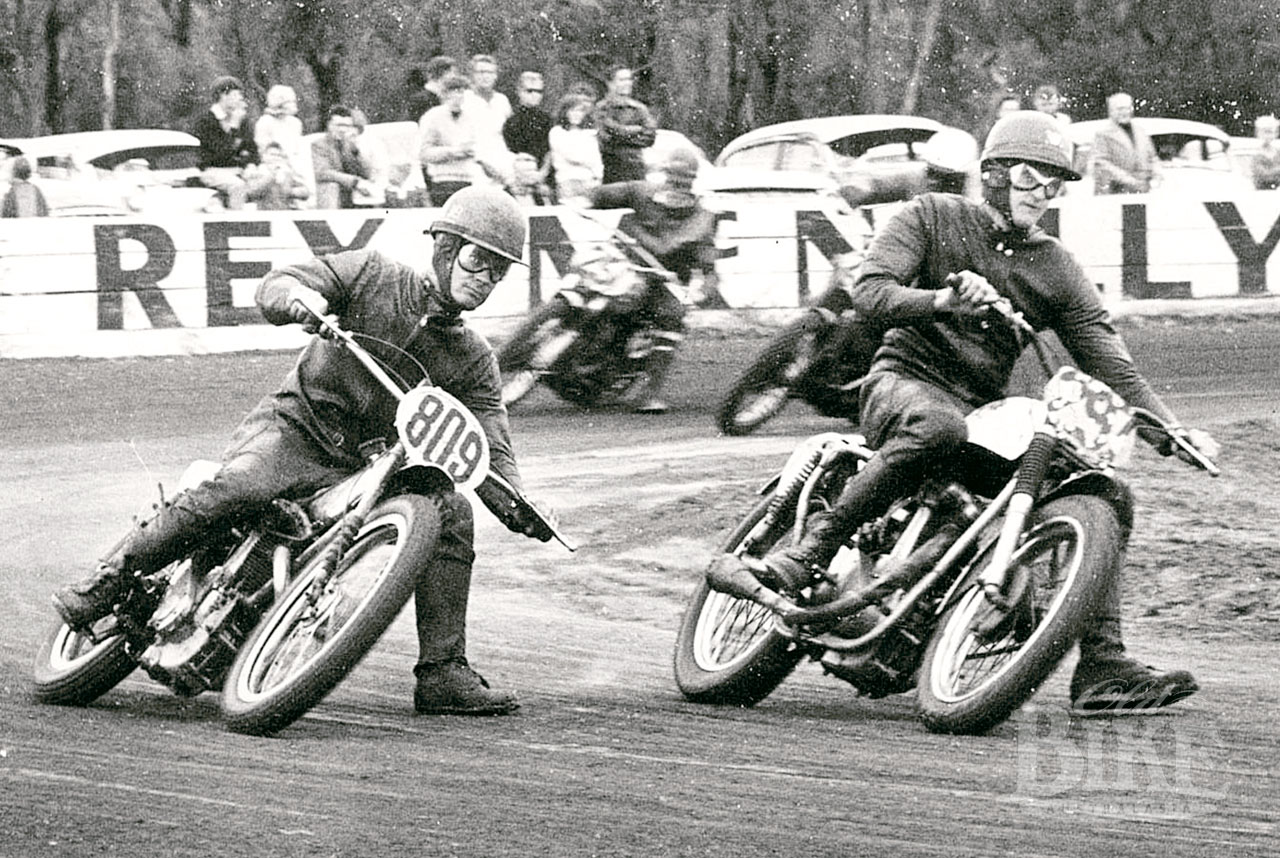
By 1964 he had a 500cc BSA Gold Star to contest Senior events as well, and immediately began challenging Dave O’Brien in the larger-capacity classes. The national titles were held at Forrestfield, near Perth that year and Herb retained his national 350 title, and led O’Brien for half the Senior final before the old master took over for his third Senior title on the trot.
About this time, Victorian all-rounder Ray Owen was a frequent visitor to some of the country NSW tracks, including Boxers Creek, Goulburn, Wambanumba at Young and Woodstock near Cowra. Owen had procured the first Hagon grass track chassis to come to Australia, which had been sent from England by Billy Street via parcel post! Ray installed a 500 JAP and had a replica frame built, into which he slotted a 350 JAP. At Cowra, Ray let Herb have a gallop on the Hagon after the meeting, and Herb knew instantly that this was the competitive edge of the future.
By early 1965, Herb had imported his own Hagon chassis, into which he installed his trusty 350 BSA engine. The spindly-looking creation was initially the source of much derision from his rivals, and Herb kept the psyche going by saying that the bike ‘handled like a broomstick”, bending and flexing even in a straight line. Then at Taree, traditionally the season opener, he let ‘em have it; smashing the outright lap record on the 350 and ‘riding the card’ at the meeting. The sniggering stopped, and soon the grids were full of the blue Hagons or locally-made copies. Jefferson and Owen had started a revolution in Australian dirt track racing. The Hagons were full seconds per lap quicker around most circuits, particularly the gloried speedways which were basically an oval with a right hand flick.
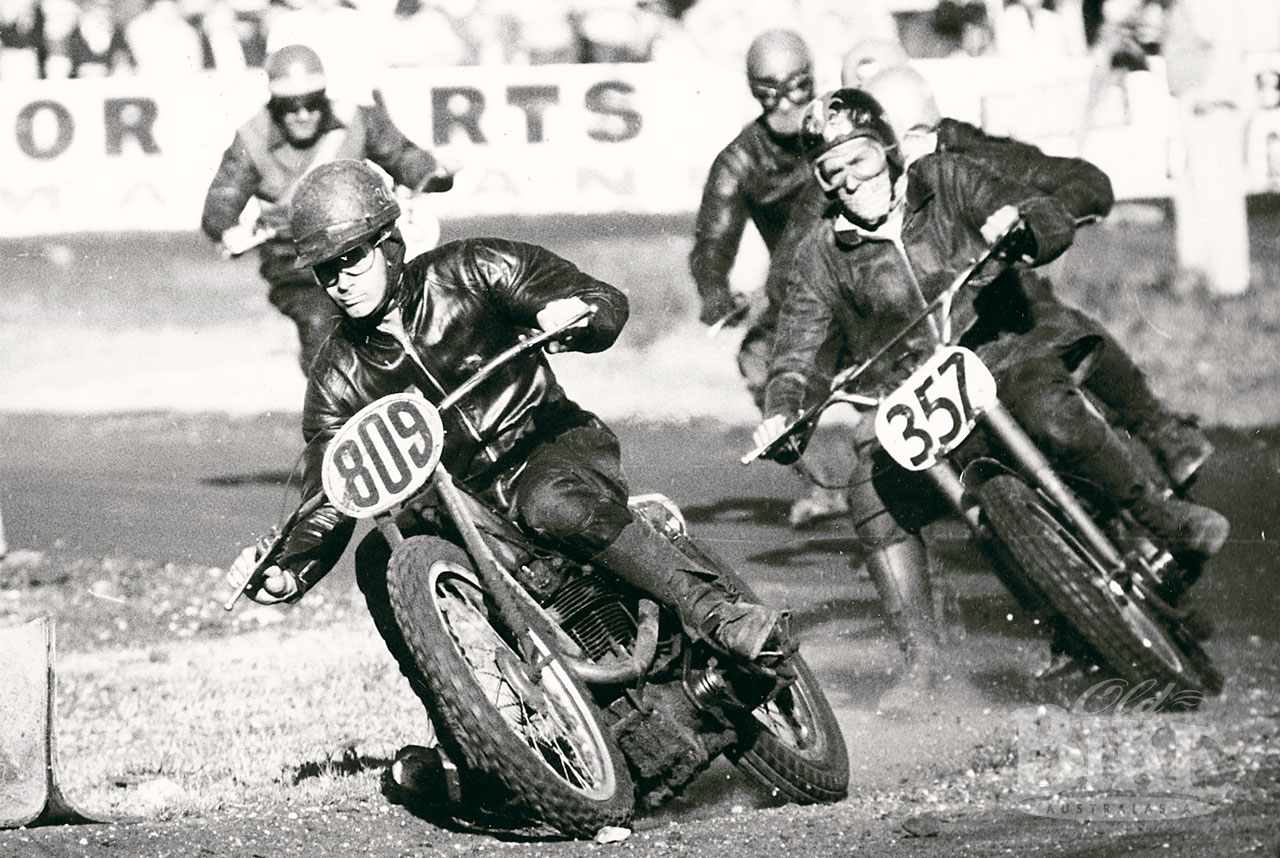
August 1965 saw the Australian Short Circuit Championships at Eagle Park, Southport where Herb took a double 350 and Unlimited crown, but still failed to shake O’Brien’s grip on the Senior title. Herb’s next big break was in early 1966, when former Australian TQ midget car champion Bill Simpson, from Kurri Kurri near Herb’s original stamping ground, assembled a Hagon fitted with an ESO (Jawa) speedway engine, and offered it to him to ride. The bike was immaculately turned out and perfectly tuned, in marked contrast to Herb’s increasingly ratty-looking 350. At any race meeting, Bill was always the first to arrive and usually had the beautiful 500 set up in the pits long before Herb arrived, bleary-eyed and occasionally the worse for wear. When Bill chided Herb about the scruffy condition of the 350, Herb’s response was, “well why don’t you polish it too?” Shortly afterwards, Bill arrived at Jefferson’s home and carefully polished exactly half of the 350 – half of each wheel, half of the engine, half the frame – then packed his kit and went home. The ploy failed. Herb turned up at the next meeting with the bike still in its 50% polished state.
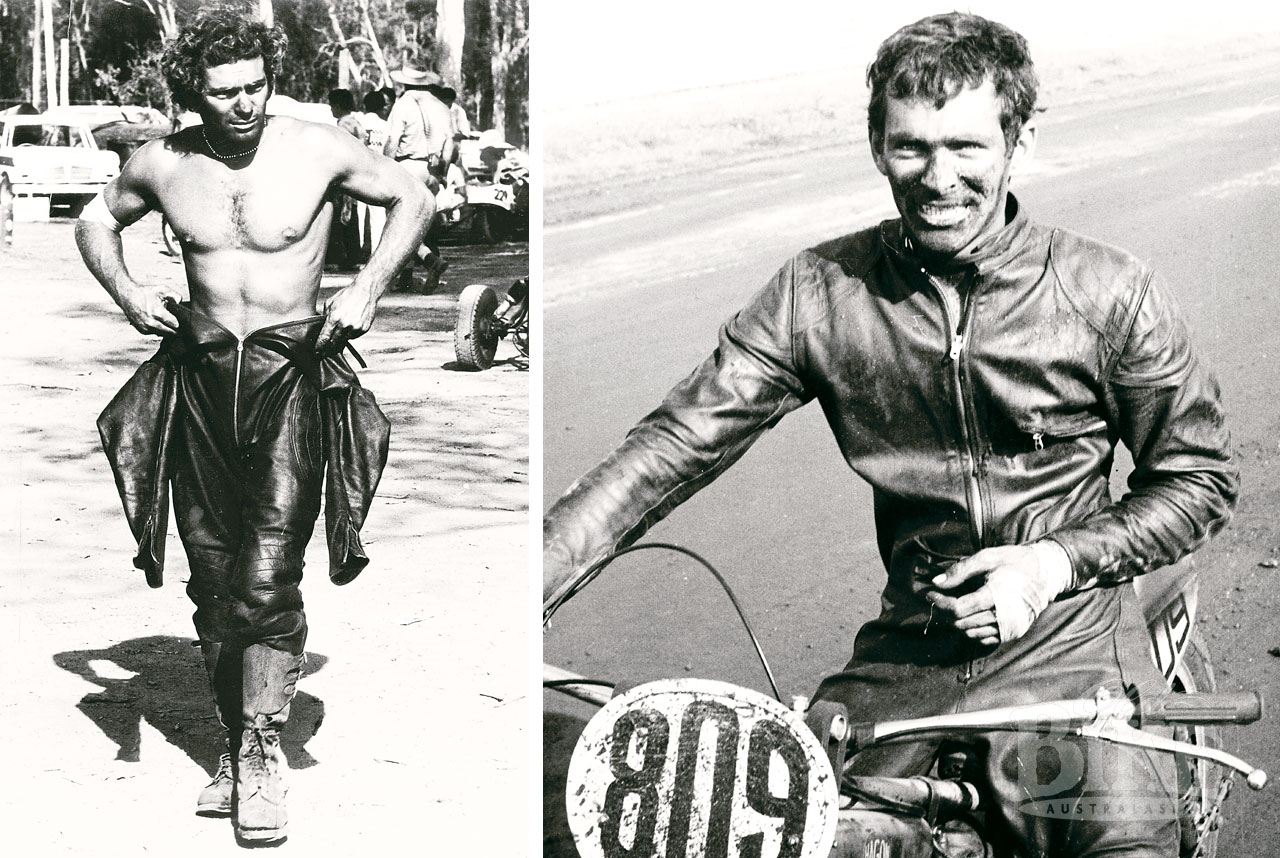
Despite the contrasting personalities, the Simpson/Jefferson partnership delivered the goods, and at Taree on September 18, 1966, he came away with the triple crown; 350, 500 and Unlimited. The result proved to be the pinnacle of his career.
He began the 1967 season in scintillating form, defeating arch rivals Jack and Keith Davies at Taree and smashing the track’s race record in the Aces Scratch, and repeated the performance a few weeks later at Heddon Greta where he led home Pat Fernance and Kevin Fraser.
By this stage the revolution to Hagon frames had really taken hold as Short Circuits became more like speedways with a right hand kink and less like the Miniature TT circuits of old. Australian agents Paul Spooner in Sydney and Don Newell in Brisbane couldn’t get enough and as well as the standard grass track model began importing the shorter wheelbase Sand Tracker. At $880 for a JAP-engined Hagon with an Albion close-ratio gearbox, or $508 less engine, there were plenty of takers. From having a Hagon monopoly in 1966, Jefferson now had to contend with Hagons in the hands of most of his main rivals, including Jack and Keith Davies, Pat Fernance, Stuart Taylor and Peter Trappel in the 500 class. Keith Davies soon secured a 350 Hagon JAP courtesy of sponsor George Parkes, and it signalled an end to Jefferson’s total dominance of the class on his iron BSA-engined Hagon.

The Davies/Jefferon rivalry raged all season, with Herb smashing the track record at Heddon Greta in May to defeat Keith and Stuart Taylor in the Unlimited A final, and making it a triple by holding off ‘KD’ in the Junior A and the Aces Scratch. Six weeks later at the same circuit, Davies had his revenge, chasing down and passing Herb in the Senior A Final. The pair went into the final corner locked together and Jefferon clipped the rear of Davies’ JAP and crashed. Herb’s father, watching from the pits, reckoned his son had no strength left after partying until 4.30am!
Indeed, Herb seemed to have less and less interest in racing and his appearances became spasmodic, finally failing to show for a meeting at Salty Creek in August for which he had entered. Rumours circulated the pits that Herb had ‘given it away’ and even had his trusty 350 (and his leathers) for sale. The Australian titles, held on a makeshift track inside the Calder Raceway in Melbourne, were without Herb Jefferson for the first time in many years, and it was left to Charlie Edwards to take over the 350 crown, while local star Ray Owen took out the Unlimited title.
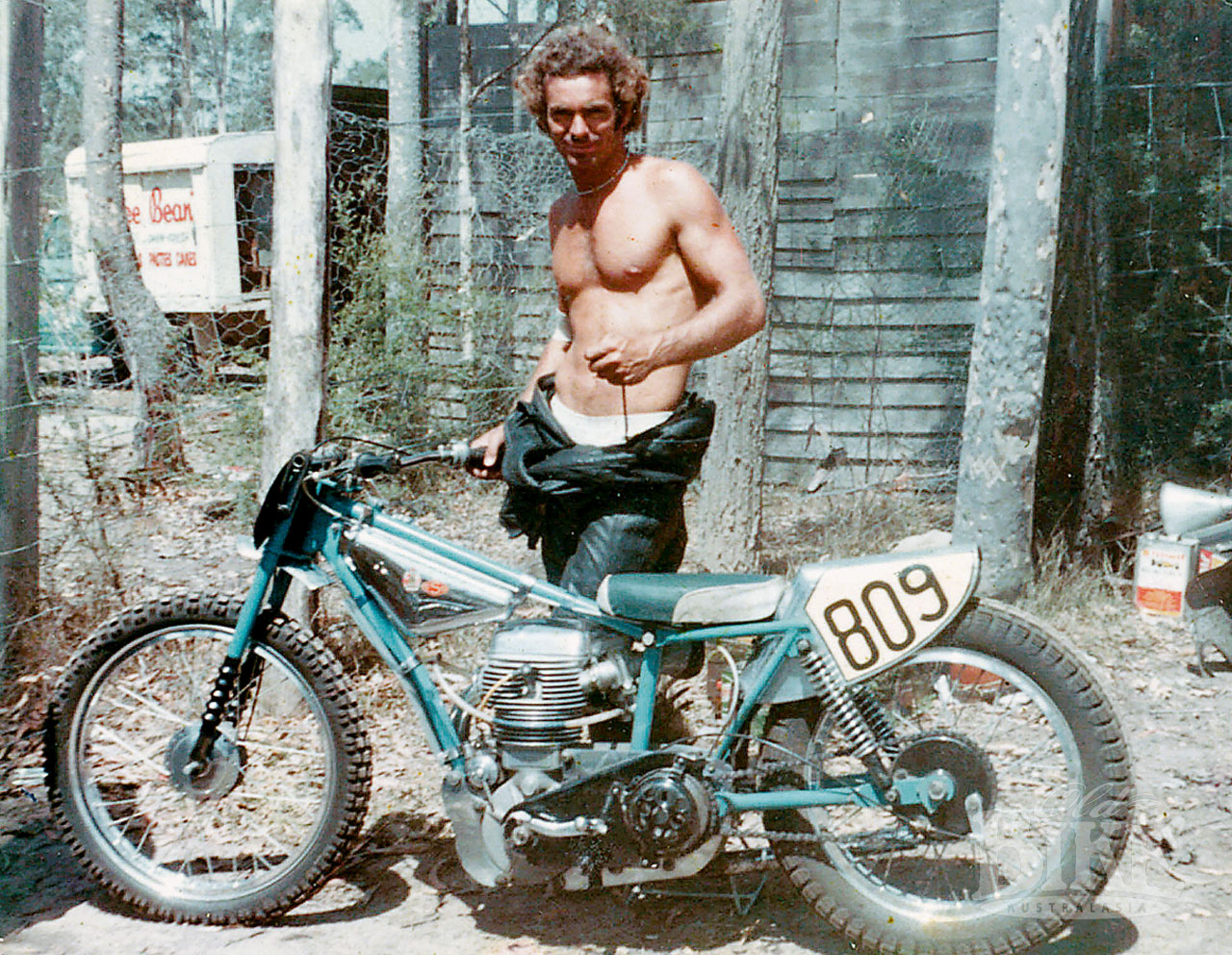
Early in the 1967 season, a fall aggravated an old injury to Herb’s left knee. In one of his first rides as a C Grader, a footrest had penetrated the knee which required surgery. Subsequent prangs, of which there were many, always seemed to affect the same leg, and now the problem was becoming acute. At the age of 24, and with a permanent limp, Herb announced his retirement, but admits now that the decision was not altogether due to the injury.
“I had more fun when I was a C Grader. In the last year or so it had reached the stage that if I didn’t win, people wanted to know why. If I did they would say “So what, he ought to win”. The only time I felt anything was being hung up after a loss’.
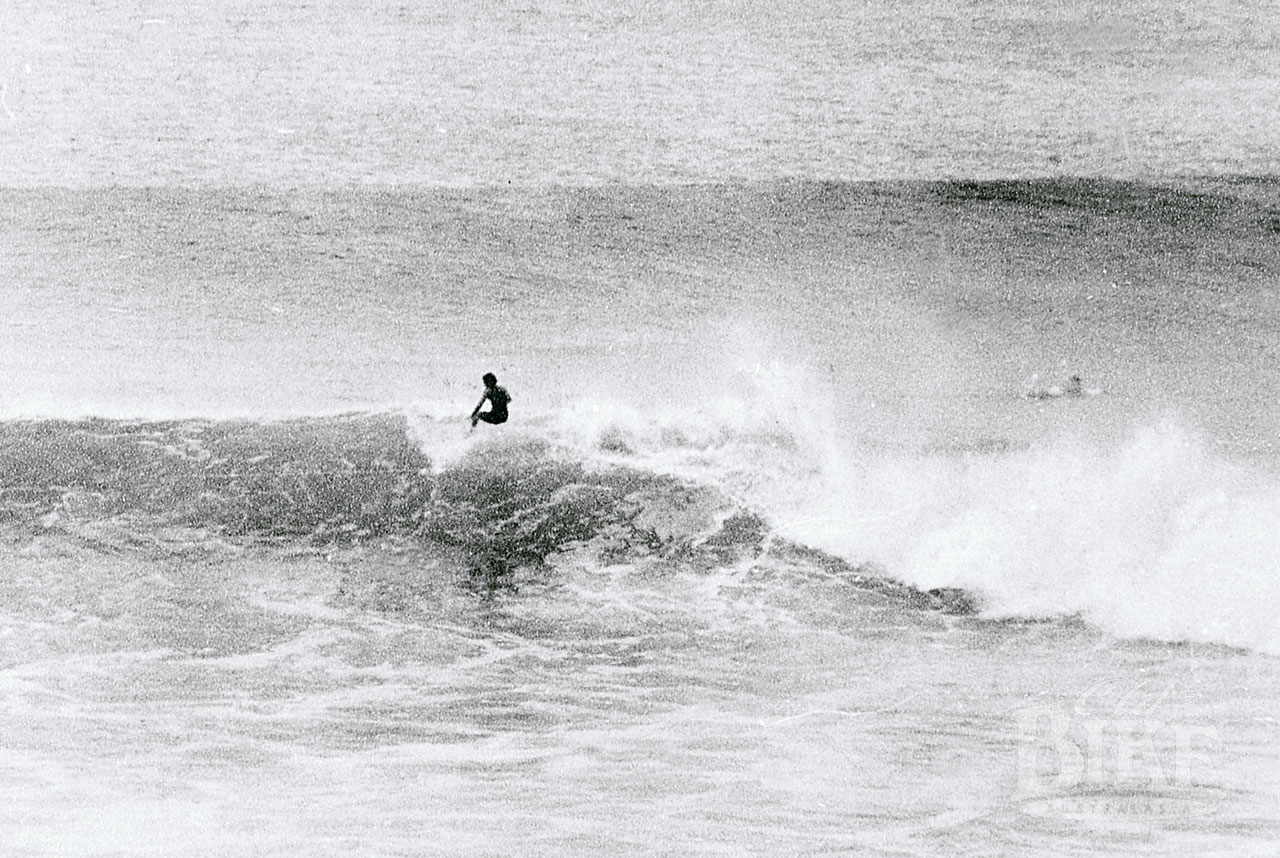
But there was another factor. Herb simply loved to surf, and he was good at it. He loved the beach, the ‘chicks’, and the lifestyle. With mates like surfing legends Wayne Lynch, Alby Falzon and Nat Young, Herb slipped naturally into the surfing scene. He bought a VW Kombi van, fitted it out as a mobile bedroom complete with ‘guest’ accommodation, and hit the beaches; from Bell’s in Victoria to the Queensland Coast. There were plenty of beaches, and certainly plenty of guests.
In an interview for the iconic magazine Surfing World in 1969, Herb explained his predicament in his inimitable style. “ I get equally stoked on a board or a bike. In the pits the smell is Castrol R fumes, the word is ‘go’. The thoughts, ‘Can I beat Harry the Lizard today?’ In the water test, the smell is salt air, the word is ‘outassight’, the thoughts: ‘I reckon Oojah Point will be firing! I like to milk the best of two worlds; surf the week and ride the weekends. I snap my brain when there’s a good wave – at least 6 to 8 feet. Slops don’t register on my thrill meter; no go.” It was the lingo of the day.
For almost two years, Herb surfed his way through life. All the while, the Hagon ESO number 809 sat in Bill Simpson’s motorcycle shop, awaiting the return of the prodigal son. In early 1969, he returned.

“I missed the scene, and I needed the bread,” was the explanation for swapping board shorts for leathers once again. Although his famous 350 had long since been sold, the Simpson 500 was still more than competitive, and he began the season at Taree, where a massive crowd piled in to see the old Jefferson versus Keith Davies rivalry renewed. The fences were packed for the final of the Senior A Grade, but Herb was slow out of the gate and trailed Davies and Queenslander Matt Daley. When Davies ran wide at the right hander, Matt shot underneath, but just metres later fell and Davies went down as well, breaking his leg. Avoiding the carnage, Herb took the chequered flag. The injury put Davies out for half the season, and things were still not right with Herb’s leg either, necessitating an operation to remove knee cartilages. Still, he added the NSW 500 title to his tally in November 1969.
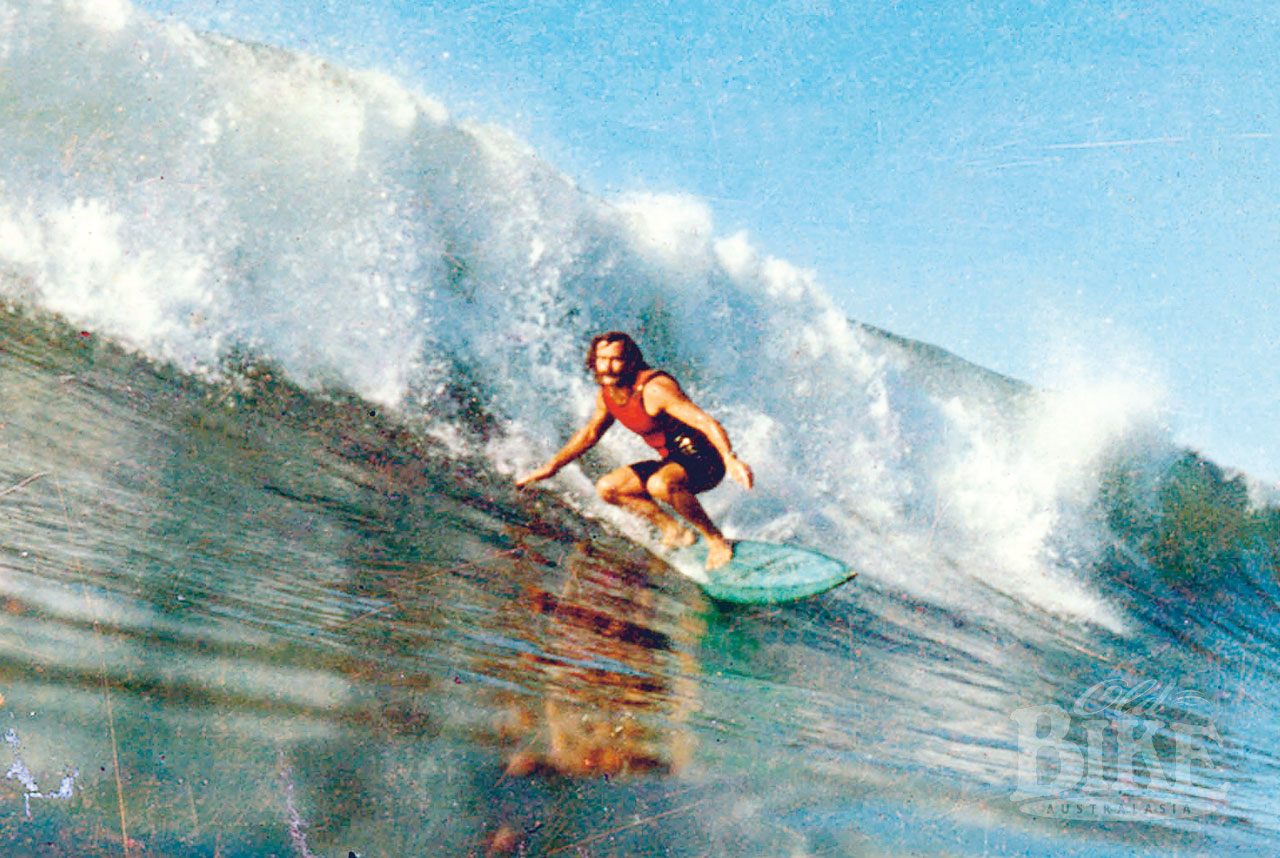
But this was to be the swan song, because after another summer of sun and surf, Herb turned his back on the sport, once again and for good. He packed his possessions and headed off to the mecca of the 70s surf scene, Hawaii, where he stayed for more than a year, working all kinds of odd jobs. San Diego was his next base, where he earned a good living as a welder for the US Navy, fitting out the USS Kittyhawk. The money all went on surfing of course, as he worked the shoreline from Northern California to Mexico for 12 more months. Heading for home, he stopped off in New Zealand for a while, then made his way to Byron Bay, where he has lived ever since.
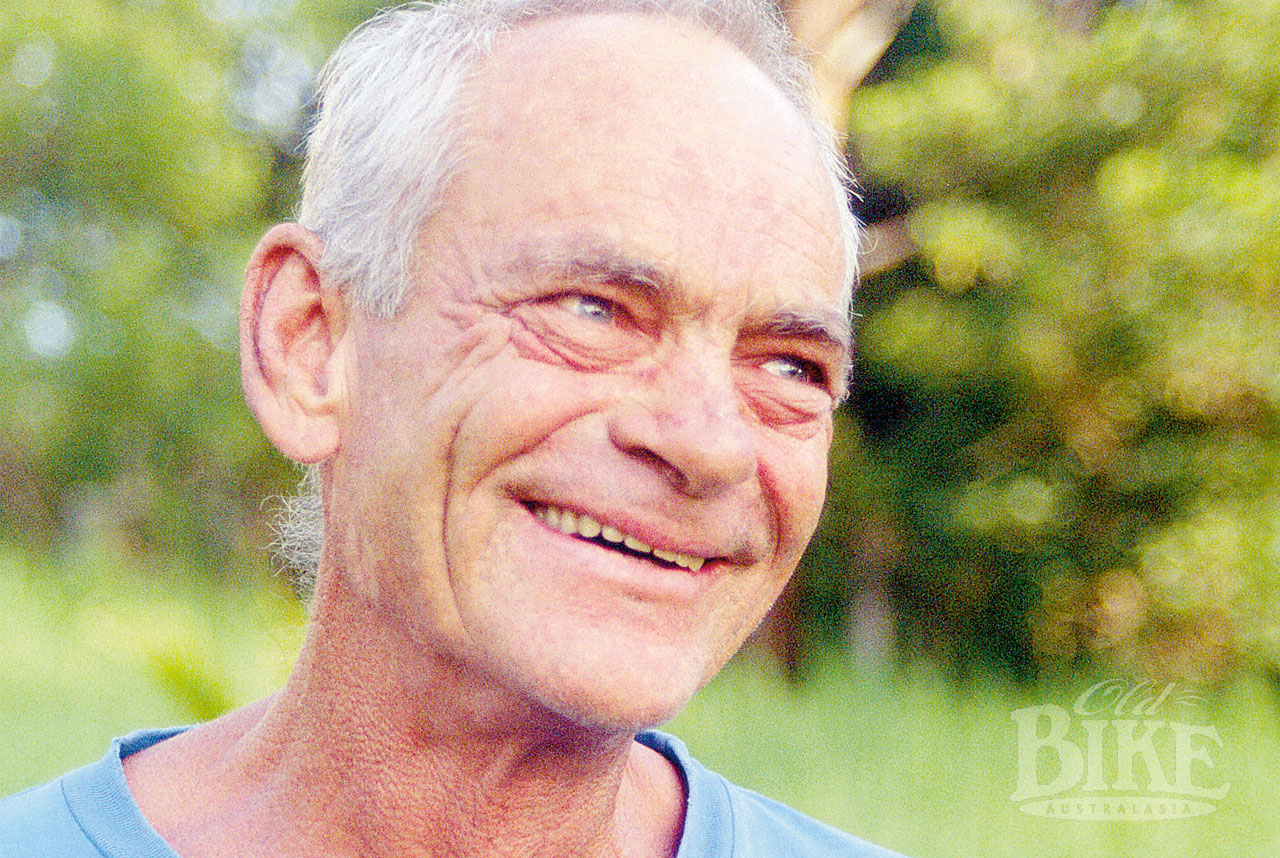
Now 67, Herb is the owner and proprietor of Warriwillah Cabins, a holiday cottage development at Broken Head, just south of Byron Bay, built with his own hands. His skin now leathery from decades in the sun, Herb seems genuinely surprised that anyone still remembers him as a racing motorcyclist.
And in reality, nearly four decades have passed since Herb last straddled a racing bike. Yet anywhere riders who plied the dirt tracks in the ‘golden era’ of the 60s and 870s gather, Herb Jefferson’s name is sure to come up.
His greatest rival? “Who ever was in front of me. I always knew exactly where I stood. I was always confident. Dave O’Brien was hard to beat, and Kevin Fraser had really quick bikes, but I reckon I could always rise to the occasion.”
Postscript: Herb Jefferson died from a stroke in early September 2023 aged 81.


